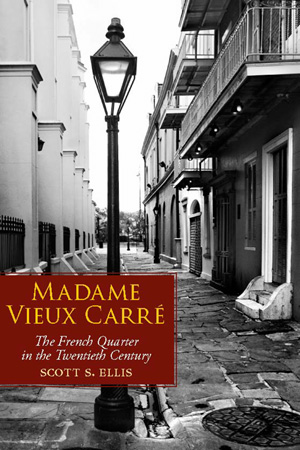| Madame Vieux Carré: The French Quarter
in the Twentieth Century was published by the University
Press of Mississippi in December 2009.
This is a holistic history of New Orleans’ French Quarter (Vieux
Carré) in the years 1900-2007. The emphasis is on social history,
since architecture is well-covered in existing works. It features
a comprehensive treatment of ethnic and social groups in this
period of history, including Italians, African-Americans, French
Creoles, Modern Creoles, gays and lesbians.
This book is loving yet blunt, unromanticized and very frank
about its topics. It was written for adults.
The reader is introduced to the setting of the Quarter at the
turn of the 19th to 20th centuries. The book examines the preservationist
movement of 1920s; role of Vieux Carré Commission and allied non-governmental
organizations; relationship with city administrations; reform
movements, housing conditions; effects of real estate values on
housing and shifts of residential groups; tourism; gentrification;
condominiums; urban planning efforts and relationships with adjacent
neighborhoods.
Comparison is drawn with other historic/enclave neighborhoods in New Orleans and other cities; revivalist movement of 1990s; ‘street people’
and management of transient groups; economics of tourism and residential infrastructure.
There is commentary on conditions prevalent at the end of the 20th century and coverage of Quarter-specific events surrounding Hurricane Katrina.
The tone is readable, enjoyable history. Intended for a popular
audience, it is documented for academic reference as well, with
endnotes in accordance with Chicago Manual of Style.
The book is structured in chronological epochs, selected on the basis of significant demarking events rather than strictly by decade.
“Interludes” are interspersed throughout to address certain topics that require coherent treatment in individual chapters.
A number of carefully chosen illustrations and maps are provided.
|


